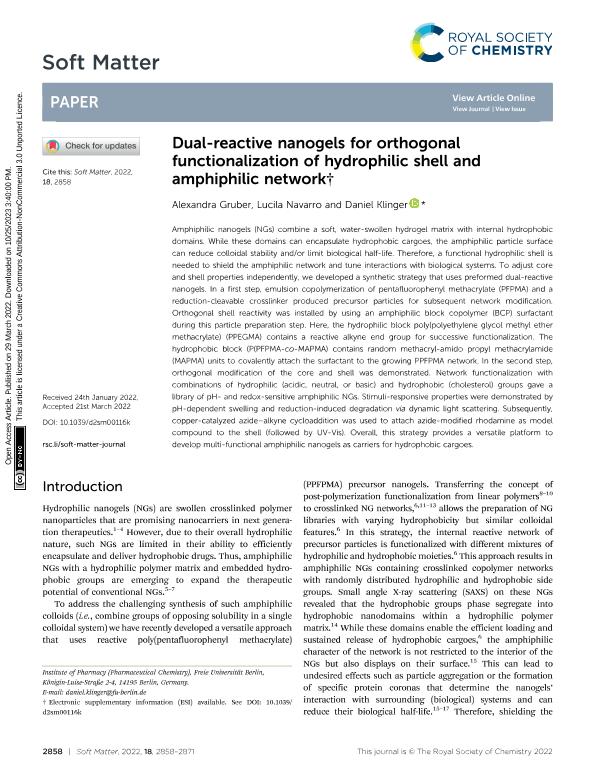Mostrar el registro sencillo del ítem
dc.contributor.author
Gruber, Alexandra
dc.contributor.author
Navarro, Lucila

dc.contributor.author
Klinger, Daniel
dc.date.available
2023-10-25T15:00:50Z
dc.date.issued
2022-03
dc.identifier.citation
Gruber, Alexandra; Navarro, Lucila; Klinger, Daniel; Dual-reactive nanogels for orthogonal functionalization of hydrophilic shell and amphiphilic network; Royal Society of Chemistry; Soft Matter; 18; 14; 3-2022; 2858-2871
dc.identifier.issn
1744-683X
dc.identifier.uri
http://hdl.handle.net/11336/215904
dc.description.abstract
Amphiphilic nanogels (NGs) combine a soft, water-swollen hydrogel matrix with internal hydrophobic domains. While these domains can encapsulate hydrophobic cargoes, the amphiphilic particle surface can reduce colloidal stability and/or limit biological half-life. Therefore, a functional hydrophilic shell is needed to shield the amphiphilic network and tune interactions with biological systems. To adjust core and shell properties independently, we developed a synthetic strategy that uses preformed dual-reactive nanogels. In a first step, emulsion copolymerization of pentafluorophenyl methacrylate (PFPMA) and a reduction-cleavable crosslinker produced precursor particles for subsequent network modification. Orthogonal shell reactivity was installed by using an amphiphilic block copolymer (BCP) surfactant during this particle preparation step. Here, the hydrophilic block poly(polyethylene glycol methyl ether methacrylate) (PPEGMA) contains a reactive alkyne end group for successive functionalization. The hydrophobic block (P(PFPMA-co-MAPMA) contains random methacryl-amido propyl methacrylamide (MAPMA) units to covalently attach the surfactant to the growing PPFPMA network. In the second step, orthogonal modification of the core and shell was demonstrated. Network functionalization with combinations of hydrophilic (acidic, neutral, or basic) and hydrophobic (cholesterol) groups gave a library of pH- and redox-sensitive amphiphilic NGs. Stimuli-responsive properties were demonstrated by pH-dependent swelling and reduction-induced degradation via dynamic light scattering. Subsequently, copper-catalyzed azide-alkyne cycloaddition was used to attach azide-modified rhodamine as model compound to the shell (followed by UV-Vis). Overall, this strategy provides a versatile platform to develop multi-functional amphiphilic nanogels as carriers for hydrophobic cargoes.
dc.format
application/pdf
dc.language.iso
eng
dc.publisher
Royal Society of Chemistry

dc.rights
info:eu-repo/semantics/openAccess
dc.rights.uri
https://creativecommons.org/licenses/by-nc/2.5/ar/
dc.subject
Nanogel
dc.subject
Anfifilico
dc.subject
Modificacion quimica
dc.subject.classification
Físico-Química, Ciencia de los Polímeros, Electroquímica

dc.subject.classification
Ciencias Químicas

dc.subject.classification
CIENCIAS NATURALES Y EXACTAS

dc.title
Dual-reactive nanogels for orthogonal functionalization of hydrophilic shell and amphiphilic network
dc.type
info:eu-repo/semantics/article
dc.type
info:ar-repo/semantics/artículo
dc.type
info:eu-repo/semantics/publishedVersion
dc.date.updated
2023-10-25T12:53:06Z
dc.journal.volume
18
dc.journal.number
14
dc.journal.pagination
2858-2871
dc.journal.pais
Reino Unido

dc.journal.ciudad
Cambridge
dc.description.fil
Fil: Gruber, Alexandra. Freie Universität Berlin; Alemania
dc.description.fil
Fil: Navarro, Lucila. Freie Universität Berlin; Alemania. Consejo Nacional de Investigaciones Científicas y Técnicas. Centro Científico Tecnológico Conicet - Santa Fe. Instituto de Desarrollo Tecnológico para la Industria Química. Universidad Nacional del Litoral. Instituto de Desarrollo Tecnológico para la Industria Química; Argentina
dc.description.fil
Fil: Klinger, Daniel. Freie Universität Berlin; Alemania
dc.journal.title
Soft Matter

dc.relation.alternativeid
info:eu-repo/semantics/altIdentifier/doi/http://dx.doi.org/10.1039/D2SM00116K
dc.relation.alternativeid
info:eu-repo/semantics/altIdentifier/url/https://pubs.rsc.org/en/content/articlelanding/2022/SM/D2SM00116K
Archivos asociados
